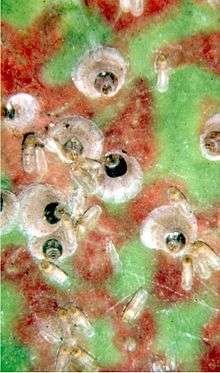Parlatoriini
Parlatoriini is a tribe of armored scale insects.[1] Takagi (2002) indicated that the Parlatoriini appear to be phylogenetically related to the Smilacicola and the Odonaspidini.[2] Takagi went on to say about the tropical east Asian Parlatoriini that, The current classification of their genera may be largely tentative because the adult females are simple-featured and much modified owing to the pupillarial mode of life, and also because the second instar nymphs are generally similar among parlatoriines, whether the adult females are pupillarial or not.[3] Andersen found that separating out pupillarial forms into a separate subtribe, Gymnaspidina, was counterproductive, as being non-dispositive.[4]
| Parlatoriini | |
|---|---|
 | |
| Scientific classification | |
| Kingdom: | |
| Phylum: | |
| Class: | |
| Order: | |
| Suborder: | |
| Superfamily: | |
| Family: | |
| Subfamily: | |
| Tribe: | Parlatoriini |
| Subtribes | |
Molecular analysis has shown that the Parlatoriini as traditionally constituted is highly non-monophyletic and that the genera, and occasionally species, are interdigitated with the Aspidiotini.[5]
Genera traditionally included in the Parlatoriini
- Agrophaspis Borchsenius & Williams, 1963
- Annulaspis Ferris, 1938 was in the Odonaspidini,
now temporarily placed in the Aspidiotinae[6] - Benaparlatoria Balachowsky, 1953
- Bigymnaspis Balachowsky, 1958
- Cryptoparlatorea Lindinger, 1905
- Cryptoparlatoreopsis Borchsenius, 1950
- Doriopus Brimblecombe, 1959
- Emmereziaspis
- Eugreeeniella
- Formosapis
- Genaparlatoria
- Gymnaspis
- Ischnafiorinia
- Kochummenaspis
- Labidaspis (Green, 1929) with one species
- Labidaspis myersi is in the Leucaspidini[7][8]
- Ligaspis
- Lindingeria
- Madaparlaspis
- Mangaspis
- Microparlatoria
- Mixaspis
- Neoparlatoria
- Neparla
- Paraparlagena
- Parlagena
- Parlaspis
- Parlatoreopsis Lindinger, 1912
- Parlatoria
- Porogymnaspis
- Sakaramyaspis
- Silvestraspis
- Sishanaspis
- Syngenaspis
- Tamilparla
- Tanaparlatoria
References
- Borchsenius, N. S. (1966). Каталог щитовок (Диаспидоидеа) мировой фауны (A catalogue of the armoured scale insects (Diaspidoidea) of the world) (in Russian). Moscow: Академия наук СССР – Зоологический институт (Zoological Institute of the USSR Academy of Sciences). p. 186.
- Takagi, Sadao (2002). "One new subfamily and two new tribes of the Diaspididae (Homoptera: Coccoidea)" (PDF). Insecta Matsumurana. 59: 55–100, page 62. Archived from the original (PDF) on 28 December 2013. Retrieved 9 January 2014.
- Takagi 2002, p. 66
- Andersen, Jeremy C.; et al. (2010). "A phylogenetic analysis of armored scale insects (Hemiptera: Diaspididae), based upon nuclear, mitochondrial, and endosymbiont gene sequences" (PDF). Molecular Phylogenetics & Evolution. 57 (3): 992–1003, page 1001. doi:10.1016/j.ympev.2010.05.002. PMID 20460159. Archived from the original on 29 December 2013.
- Andersen 2010, p. 998
- "Annulaspis (Diaspididae) is the valid name". Scale Net. Archived from the original on 2014-01-09.
- Andersen 2010, p. 1000
- Henderson, Rosa C. (2008). "Extinctions and radiations in the New Zealand scale insect fauna". In Branco, Manuela; Franco, José Carlos; Hodgson, Chris (eds.). Proceedings of the XI International Symposium on Scale Insect Studies, Oeiras, Portugal, 24-27 September 2007 (PDF). Lisbon: ISA. pp. 89–94. ISBN 978-972-8669-33-1. Archived (PDF) from the original on 9 January 2014.